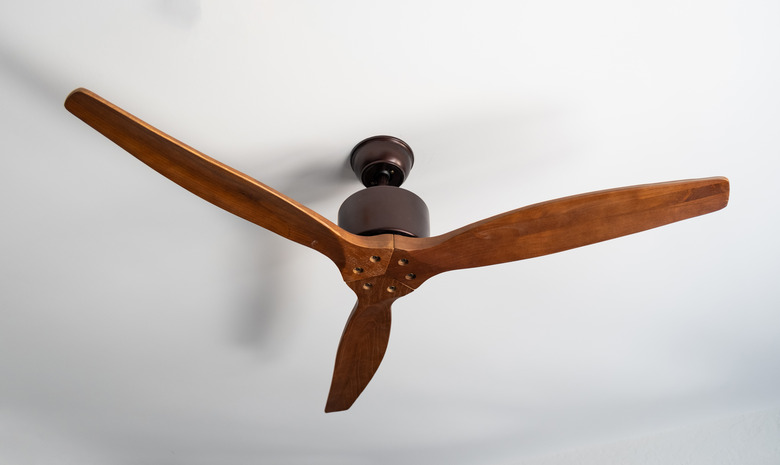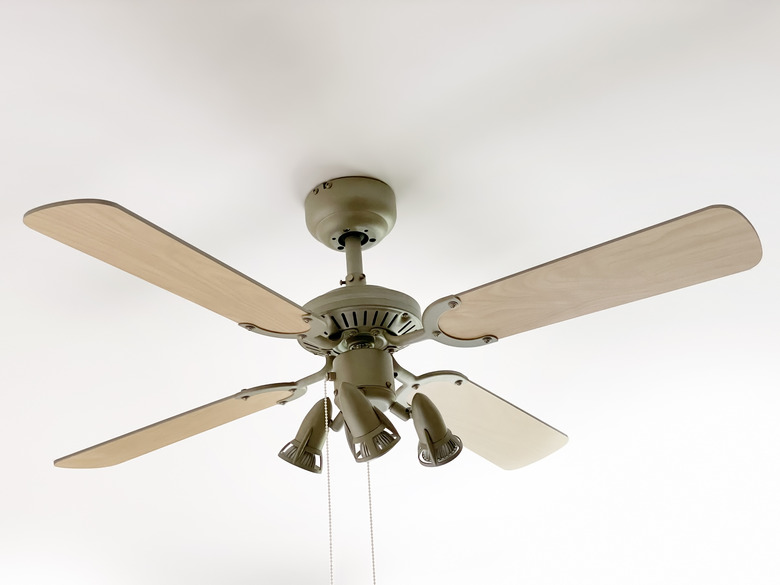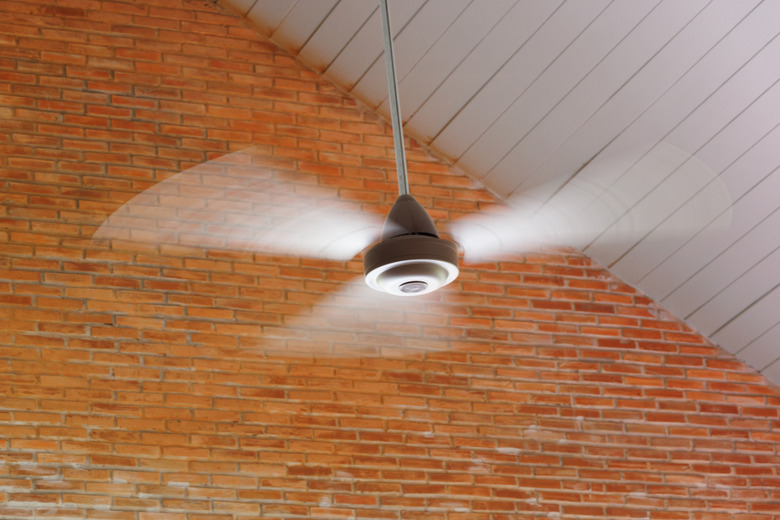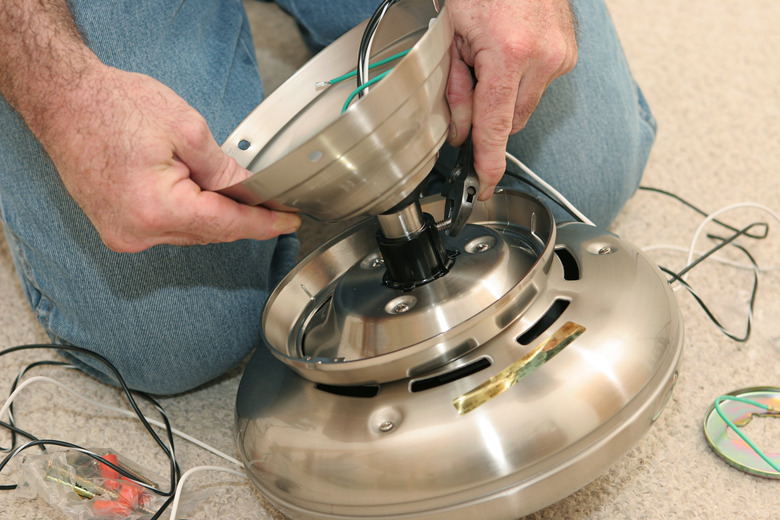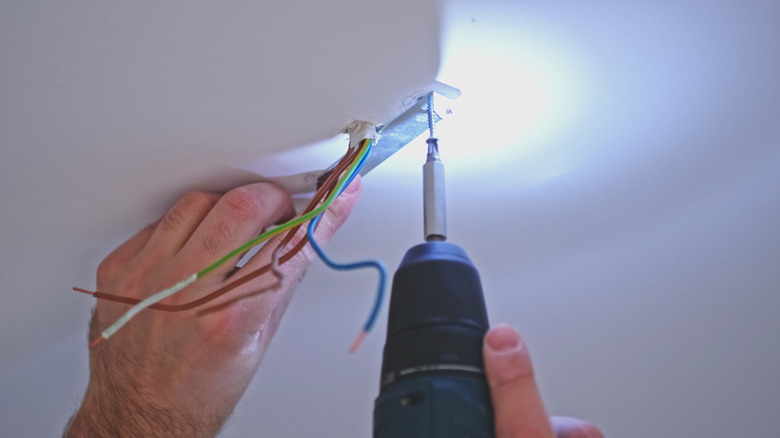Ceiling Fan Electrical Box: How To Choose The Right One
We may receive a commission on purchases made from links.
A ceiling fan mounts to the ceiling just like a light fixture, but a fan needs more support, and it's the job of the electrical box to provide it. The National Electrical Code requires all ceiling fans weighing 35 pounds or more to be installed on an electrical box listed for ceiling fan installation. Given the torque and vibrations generated by the fan blades, it's prudent to install fans lighter than this on a fan box as well.
Unlike a light fixture box, a ceiling fan box must always be supported by a joist, and it's easier to install one before the ceiling drywall has been installed. A new-work box, which you install during new construction, has a support bracket that screws to a pair of adjacent joists. However, if you're replacing a light fixture with a ceiling fan or your existing fan is mounted on a light fixture box, you can replace the existing box with an old-work box, which either gets screwed directly to the joist or has a tension bar that wedges between a pair of joists.
Some manufacturers provide the electrical box in the fan packaging, but not all do, so you might need to purchase the ceiling box for your new (or used) fan separately. Fan-rated boxes from manufacturers such as Raco and Legrand are available from any electrical supply retailer. Here are some tips to help you choose the right ceiling fan box.
Choosing Ceiling Fan Boxes
Choosing Ceiling Fan Boxes
Ceiling fan electrical boxes can be made of PVC or another durable plastic, but most are metal, which offers more support strength. Fan boxes are always round or octagonal (not rectangular). Two types are available: new-work and old-work boxes.
New-Work Box
You'll want a new-work box if you're installing it in a ceiling that hasn't been drywalled because you have access to the joists and can screw the bracket or brackets to them. Some side-mount models have a single tab that you screw to the side of a joist and are hanger-style with two arms that extend between a pair of joists and gets screwed to both of them. The choice depends on the position of the fan relative to the joists.
Old-Work Box
The type of old-work box you need when installing a fan with existing drywall also depends on the fan's position relative to the joists. If the fan is mounted directly over a joist, you can use either a ceiling pan box or a saddle box. Both get screwed directly to the joist from underneath, but a pan box is only 1/2 inch deep — just enough for the wires. If you need more room to work, choose a saddle box, which has extended sides that fit around the faces of the joist and provide more room for wires. Both of these boxes can also be used for new construction.
When the fan is mounted between joists, an old-work box needs a bracing bar just like a new-work box does, but if you don't have attic access, there's no way to screw the brace to the joists. In that case, you need a retrofit bracing bar, which works like a tension bar for a shower curtain. You insert the bar through the hole in the ceiling, twist it to extend the ends until they clamp against the joists, and then attach the box to the tension bar using the provided bracket.
Spinning Adds Weight to Ceiling Fans
Spinning Adds Weight to Ceiling Fans
A ceiling fan typically weighs anywhere from 15 to 35 pounds depending on the length of the blades and whether or not it has a light kit, but that's just dead weight. When the fan is spinning, the torque it continuously applies to the electrical box is like extra weight. While it isn't always easy to quantify the difference, a fair estimate of the added weight of a spinning fan is about 15 to 20 pounds. So, a fan that weighs 20 pounds when it's stationary exerts a force in the neighborhood of 35 to 40 pounds when it's spinning.
You don't have to worry about calculating this difference when purchasing a ceiling box because the manufacturer has done it already. Fan-rated ceiling boxes are typically rated for a maximum load of 70 pounds, which is considerably more than the dead weight of most fans. Some heavy-duty boxes are rated for larger loads, but you need one of these only if the fan is extremely large or heavy.
Do You Need a New Ceiling Fan Box?
Do You Need a New Ceiling Fan Box?
If you're replacing a light fixture with a ceiling fan, there's a possibility that you won't need a new ceiling fan box, especially if the light fixture is heavy. Conversely, you may have an existing ceiling fan mounted on a box that isn't fan-rated, in which case you need to replace the box. A fan mounted on a box that isn't designed to hold it can fall.
A preliminary test for a fan-rated box is to try to wiggle it after you remove the light fixture or fan. A fan-rated box is secured to the joists and won't move, while a light fixture box mounted only to the ceiling often may have plenty of play, or it may push in relatively easily on one side. After doing this test, look for a label inside the box. It should say "acceptable for fan support" or something similar, and it should indicate the maximum weight of the fan it can support. If you have attic access, you can inspect the box for fixture support (braces or tabs holding it to the joists) and a label, which is sometimes affixed to the outside of the box as well as the inside.
How to Install a Ceiling Fan Box
How to Install a Ceiling Fan Box
Besides supporting the fan, a ceiling box also serves as a junction box for the electrical wires, so there are knockout holes for the wires on the back of the box. Fit these holes with nonmetallic cable clamps to protect the wiring, which you then feed into the box prior to affixing the box to the joists.
Here's how to install a new-work ceiling fan box:
- Either screw the new box to a joist (if it's a side-mount model with a tab) or extend the hanger until it touches the joists on either side and screw it to the joists. If you have attic access, you can do this from above even if the ceiling is drywalled.
- Slide the box into position and tighten down the nuts holding it to the hanger.
Here's how to mount an old-work ceiling fan box between joists:
- Insert the bracing bar through the hole in the ceiling
- Rotate it to lengthen it and wedge it into place
- Set the box into position and tighten the screws or nuts to secure it. Boxes from different manufacturers install slightly differently, so be sure to read the instructions supplied with yours.
- Once the box is secure, you're ready to wire the fan — being sure to cap all wire splices with appropriate connectors — and secure the fan to the box with the mounting screws that come with the fan.
Using the right screws is critical. Many ceiling fan boxes will specify the screw size and thread count required to meet the load rating of the box. If you use the wrong screws, the installation may be in jeopardy no matter how strong the box is or how securely you mount it. Skimpy screws can actually break or shear off due to the fan's weight and motion.
Confirm that the screws provided with your fan meet the screw specifications on the box. If you need replacement screws for any reason, make sure to get the right type for the box. A commonly specified screw is a 10-24 — that is, a #10 machine screw with 24 threads per inch.
Tip
When installing an old-work box, you may first have to remove an existing fixture box. The easiest way to DIY this is to pound it out using a block of wood and a hammer, but sometimes, you might find it necessary to cut a notch in the drywall to expose the fasteners holding the box to the joists and cut the fasteners with a reciprocating saw or a hacksaw blade. Of course, if the old box is mounted over a joist and not recessed into the drywall, you can just unscrew it and screw the new box in the same position.
